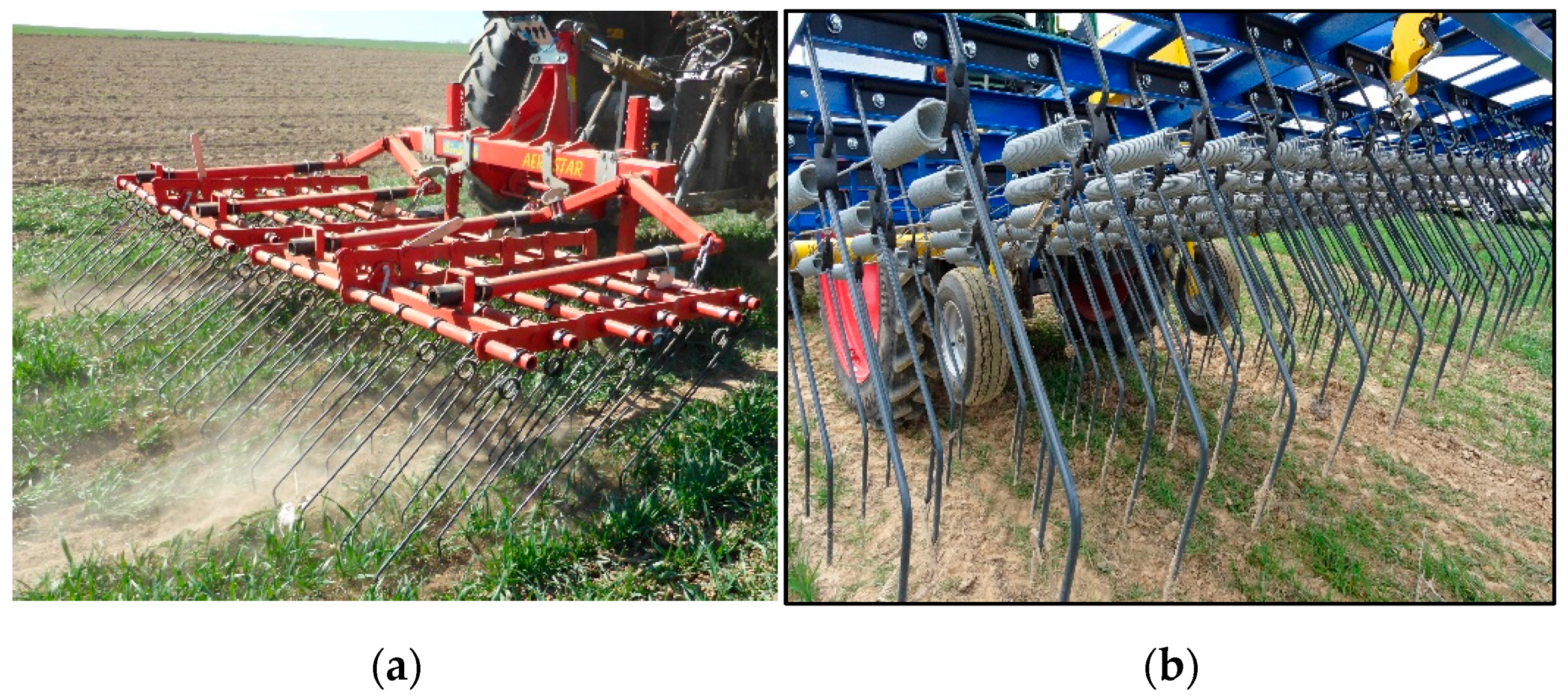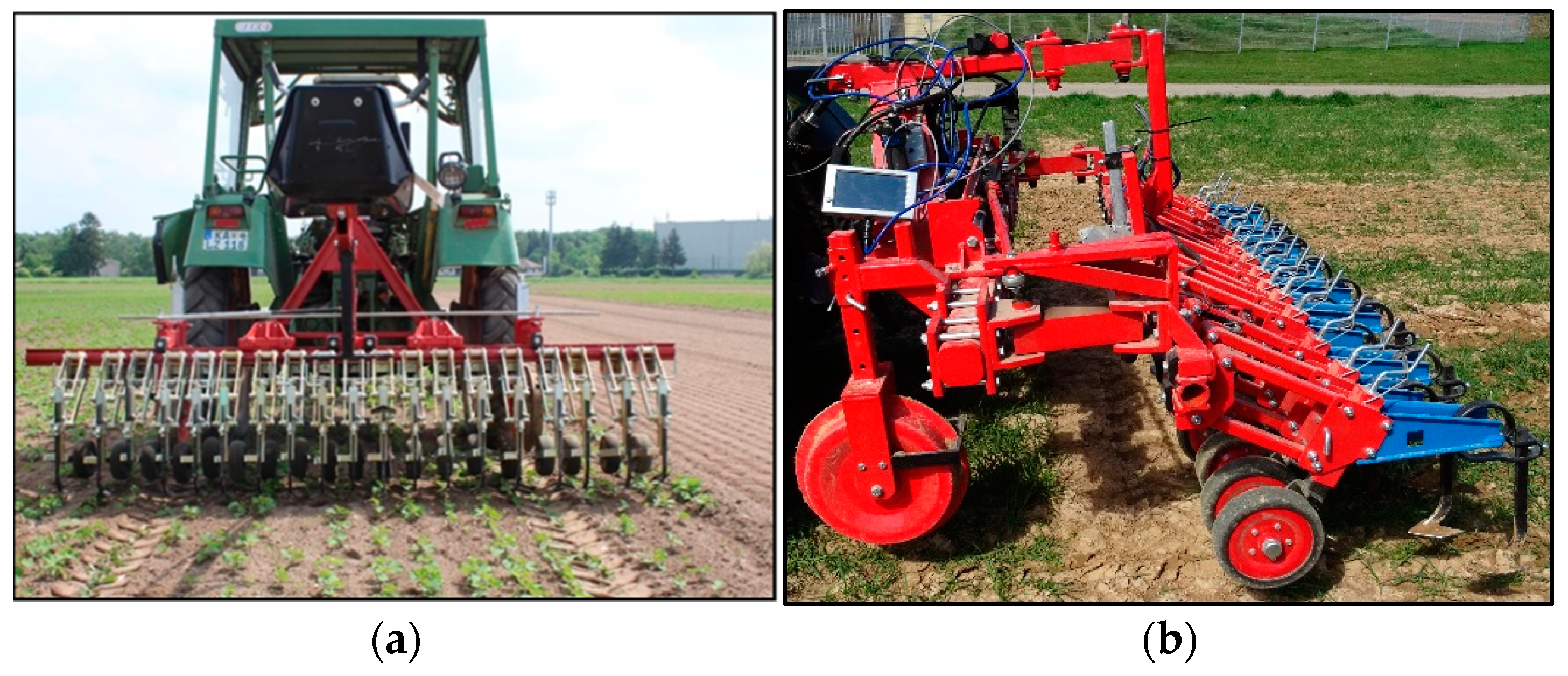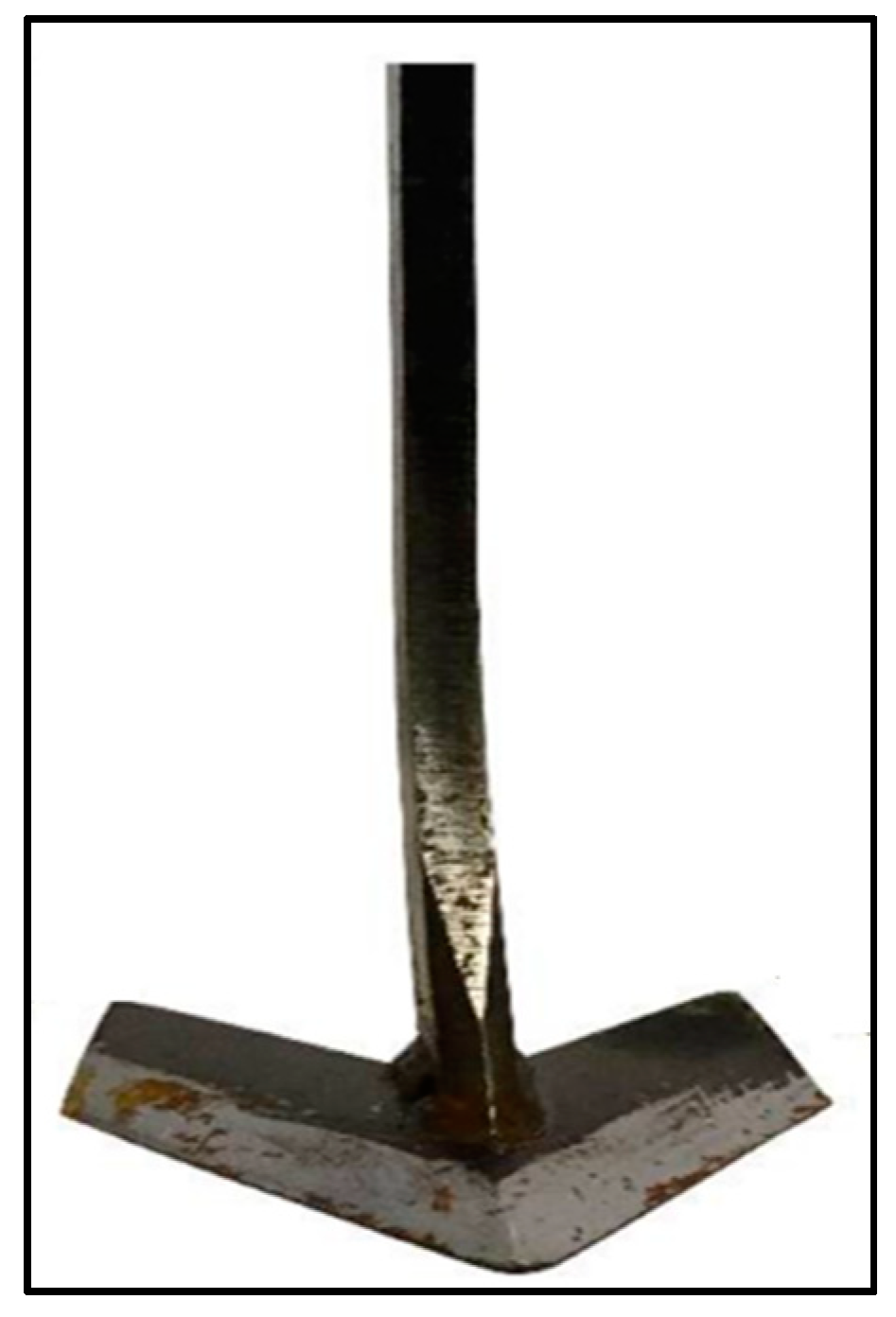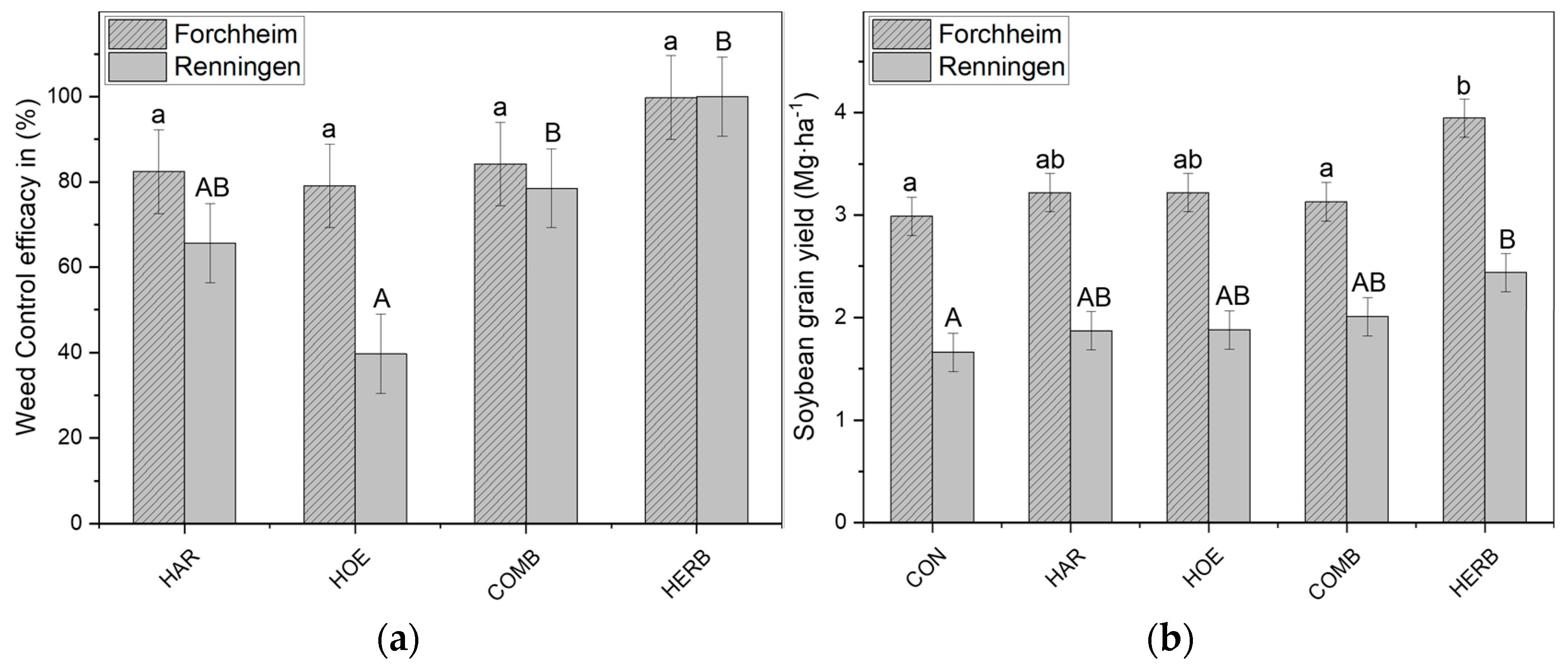Efficacy of Various Mechanical Weeding Methods—Single and in Combination—In Terms of Different Field Conditions and Weed Densities
Abstract
:1. Introduction
2. Materials and Methods
2.1. Experimental Sites and Design
2.2. Machine Types, Steering, and Implements
2.3. Data Collection and Analysis
3. Results
3.1. Weed Composition
3.2. Weed Control Efficacy and Grain Yield
3.2.1. Results in Winter Wheat
3.2.2. Results in Pea
3.2.3. Results in Soybean
3.3. Performance at Different Weed Density Levels
4. Discussion
5. Conclusions and Outlook
Author Contributions
Funding
Acknowledgments
Conflicts of Interest
References
- Gerhards, R.; Santel, H.-J. Biologie und Ökologie der Unkräuter. Biologie und Bekämpfung der Unkräuter, 1st ed.; University of Hohenmeim, Herbology 360b: Stuttgart, Germany, 2017; pp. 7–14. [Google Scholar]
- Mehrtens, J.; Schulte, M.; Hurle, K. Unkrautflora in Mais: Ergebnisse eines Monitorings in Deutschland. Gesunde Pflanzen 2005, 57, 206–218. [Google Scholar] [CrossRef]
- Hock, S.M.; Knezevic, S.Z.; Martin, A.R.; Lindquist, J.L. Soybean row spacing and weed emergence time influence weed competitiveness and competitive indices. Weed Sci. 2006, 54, 38–46. [Google Scholar] [CrossRef] [Green Version]
- Oerke, E.-C. Crop losses to pests. J. Agric. Sci. 2006, 144, 31–43. [Google Scholar] [CrossRef]
- Keller, M.; Gantoli, G.; Kipp, A.; Gutjahr, C.; Gerhards, R. The effect and dynamics of weed competition on maize in Germany and Benin. In Proceedings of the 25th German Conference on Weed Biology and Weed Control, Braunschweig, Germany, 13–15 March 2012; University of Hohenheim, Institute of Phytomedicine: Stuttgart, Germany, 2012. [Google Scholar]
- Keller, M.; Gantoli, G.; Möhring, J.; Gutjahr, C.; Gerhards, R.; Rueda-Ayala, V. Integrating Economics in the Critical Period for Weed Control Concept in Corn. Weed Sci. 2014, 62, 608–618. [Google Scholar] [CrossRef] [Green Version]
- Keller, M.; Böhringer, N.; Möhring, J.; Rueda-Ayala, V.; Gutjahr, C.; Gerhards, R. Changes in Weed Communities, Herbicides, Yield Levels and Effect of Weeds on Yield in Winter Cereals Based on Three Decades of Field Experiments in South-Western Germany. Gesunde Pflanzen 2015, 67, 11–20. [Google Scholar] [CrossRef]
- Heap, I. The International Herbicide-Resistant Weed Database. Available online: www.weedscience.org/ (accessed on 29 April 2021).
- Kemfert, C. Green Deal for Europe: More Climate Protection and Fewer Fossil Fuel Wars. Intereconomics 2019, 6, 353–358. [Google Scholar] [CrossRef] [Green Version]
- European Parliament and Council of the EU. Directive 2009/128/EC of the European Parliament and of the Council of 21st October 2009 establishing a framework for Community action to achieve the sustainable use of pesticides. Offic. J. EU 2009, L 309, 71–86. [Google Scholar]
- Dayan, E. Current Status and Future Prospects in Herbicide Discovery. Plant 2019, 8, 341. [Google Scholar] [CrossRef] [Green Version]
- Pannell, D.J.; Tillie, P.; Rodríguez-Cerezo, E.; Ervin, D.; Frisvold, G.B. Herbicide resistance: Economic and environmental challenges. AGBIOFORUM 2016, 19, 136–155. [Google Scholar]
- Shaw, D.R. The “Wicked” nature of the herbicide resistance problem. Weed Sci. 2016, 64, 552–558. [Google Scholar] [CrossRef]
- Ascard, J.; Hatcher, P.E.; Melander, B.; Upadhyaya, M.K. Thermal Weed Control. In Non-Chemical Weed Management. Principles, Concepts and Technology; Upadhyaya, M.K., Blackshaw, R.E., Eds.; CABI: Wallingford, UK, 2007; pp. 155–175. [Google Scholar]
- Peteinatos, G.G.; Weis, M.; Dionisio, A.; Rueda-Ayala, V.; Gerhards, R. Potential use of ground-based sensor technologies for weed detection. Pest Manag. Sci. 2014, 70, 190–199. [Google Scholar] [CrossRef]
- Peteinatos, G.; Gierer, F.; Gerhards, R. Precision harrowing using a bispectral camera and a flexible tine harrow. Julius-Kühn-Archiv 2018, 458, 385–389. [Google Scholar]
- Gerhards, R.; Kollenda, B.; Machleb, J.; Moeller, K.; Butz, A.; Reiser, D.; Griepentrog, H.W. Camera-guided Weed Hoeing in Winter Cereals with Narrow Row Distance. Gesunde Pflanzen 2020, 72, 403–411. [Google Scholar] [CrossRef]
- Machleb, J.; Peteinatos, G.G.; Kollenda, B.L.; Andújar, D.; Gerhards, R. Sensor-based mechanical weed control: Present state and prospects. Comput. Electron. Agric. 2020, 176, 105638. [Google Scholar] [CrossRef]
- Kunz, C.; Weber, J.F.; Gerhards, R. Benefits of Precision Farming Technologies for Mechanical Weed Control in Soybean and Sugar Beet—Comparison of Precision Hoeing with Conventional Mechanical Weed Control. Agronomy 2015, 5, 130–142. [Google Scholar] [CrossRef] [Green Version]
- Kunz, C.; Weber, J.F.; Peteinatos, G.G.; Sökefeld, M.; Gerhards, R. Camera steered mechanical weed control in suger beet, maize and soybean. Precis. Agric. 2017, 19, 708–720. [Google Scholar] [CrossRef]
- Machleb, J.; Kollenda, B.L.; Peteinatos, G.G.; Gerhards, R. Adjustment of Weed Hoeing to Narrowly Spaced Cereals. Agriculture 2018, 8, 54. [Google Scholar] [CrossRef] [Green Version]
- Kollenda, B.L. Development of Hoeing in Narrow Seeded Cereals with a Camera Row Guidance. Ph.D. Thesis, Faculty of Agricultural Sciences, University of Hohenheim, Stuttgart, Germany, 2019. [Google Scholar]
- Rasmussen, J.; Bibby, B.M.; Schou, A.P. Investigating the selectivity of weed harrowing with new methods. Weed Res. 2008, 48, 523–532. [Google Scholar] [CrossRef] [Green Version]
- Rasmussen, J.; Svenningsen, T. Selective Weed Harrowing in Cereals. Biol. Agric. Hortic. 1995, 12, 29–46. [Google Scholar] [CrossRef]
- Kurstjens, D.A.G.; Perdok, U.D. The selective soil covering mechanism of weed harrows on sandy soil. Soi. Till. Res. 2000, 55, 193–206. [Google Scholar] [CrossRef]
- Weber, J.F.; Kunz, C.; Gerhards, R. Chemical and mechanical weed control in soybean (Glycine max). In Proceedings of the 27th German Conference on Weed Biology and Weed Control, Braunschweig, Germany, 23–25 February 2016; University of Hohenheim, Institute of Phytomedicine: Stuttgart, Germany, 2016. [Google Scholar]
- Spaeth, M.; Machleb, J.; Peteinatos, G.G.; Saile, M.; Gerhards, R. Smart Harrowing—Adjusting the Treatment Intensity Based on Machine Vision to Achieve a Uniform Weed Control Selectivity und Heterogeneous Field Conditions. Agronomy 2020, 10, 1925. [Google Scholar] [CrossRef]
- Lancashire, P.D.; Bleiholder, H.; Den Boom, T.V.; Langeluddeke, P.; Stauss, R.; Weber, E.; Witzenberger, A. A uniform decimal code for growth stages of crops and weeds. Ann. Appl. Biol. 1991, 119, 561–601. [Google Scholar] [CrossRef]
- Nkoa, R.; Owen, M.D.K.; Swanton, C.J. Weed Abundance, Distribution, Diversity, and Community Analyses. Weed Sci. 2015, 63, 64–90. [Google Scholar] [CrossRef] [Green Version]
- Rasmussen, J. A Model for Prediction of Yield Response in Weed Harrowing. Weed Res. 1991, 31, 401–408. [Google Scholar] [CrossRef]
- R Core Team. R: A Language and Environment for Statistical Computing; R Foundation for Statistical Computing: Vienna, Austria, 2021; Available online: https://www.R-project.org/ (accessed on 29 April 2021).
- Gerhards, R.; Weber, J.F.; Kunz, C. Evaluation of weed control efficacy and yield response of inter-row and intra-row hoeing technologies in maize, sugar beet and soybean. Landtechnik 2020, 75, 247–260. [Google Scholar]
- Manzone, M.; Demeneghi, M.; Marucco, P.; Grella, M.; Balsari, P. Technical solutions for under-row weed control in vineyards: Efficacy, costs and environmental aspects analysis. J. Agric. Eng. 2020, 991, 36–42. [Google Scholar] [CrossRef] [Green Version]
- Melander, B.; Cirujeda, A.; Jorgensen, M.H. Effects of inter-row hoeing and fertilizer placement on weed growth and yield of winter wheat. Weed Res. 2003, 43, 428–438. [Google Scholar] [CrossRef]
- Vizantinopoulos, S.; Katranis, N. Management of Blackgrass (Alopecurus myosuroides) in Winter Wheat in Greece. Weed Technol. 1998, 12, 484–490. [Google Scholar] [CrossRef]
- Gerowitt, B.; Heitefuss, R. Weed economic thresholds in cereals in the Federal Republic of Germany. Crop Prot. 1990, 9, 323–331. [Google Scholar] [CrossRef]
- Rasmussen, I.A. The effect of sowing date, stale seedbed, row width and mechanical weed control on weeds and yields of organic winter wheat. Weed Res. 2004, 44, 12–20. [Google Scholar] [CrossRef]
- Melander, B.; Rasmussen, I.A.; Barberi, P. Integrating physical and cultural methods of weed control -examples from European research. Weed Sci. 2005, 53, 369–381. [Google Scholar] [CrossRef]
- Brandsaeter, L.O.; Mangerud, K.; Rasmussen, J. Interactions between pre- and post-emergence weed harrowing in spring cereals. Weed Res. 2012, 52, 338–347. [Google Scholar] [CrossRef]






| Details | Renningen (48.74° N, 8.92° E) | Odenheim (49.18° N, 8.77° E) | Forchheim (48.96° N, 8.33° E) |
|---|---|---|---|
| Sea level Long-term average precipitation Long-term average temperature Soil composition | 475 m | 180 m | 117 m |
| 738 mm | 776 mm | 742 mm | |
| 8.4 °C Clay 28%, Sand 12.5%, Silt 60% | 9.3 °C Clay 15%, Sand 8%, Silt 77% | 10.1 °C Clay 6%, Sand 73%, Silt 21% |
| Crop Type | Location | Variety | Sowing | Seed Density | Harvesting |
|---|---|---|---|---|---|
| Winter wheat | Renningen | Patras | 18 October 2017 | 350 seeds∙m−2 | 26 July 20218 |
| Odenheim | Rubisko | 23 October 2018 | 330 seeds∙m−2 | 22 July 2019 | |
| Pea | Forchheim | Astronaute | 23 March 2018 | 225 kg∙ha−1 | 5 July 2018 |
| Renningen | Respect | 1 April 2019 | 260 kg∙ha−1 | 8 August 2019 | |
| Soybean | Forchheim | Solena | 20 April 2018 | 65 seeds∙m−2 | 12 September 2018 |
| Renningen | Solena | 20 May 2020 | 70 seeds∙m−2 | 7 November 2020 |
| Crop Type | Location | Year | Harrow Type | Hoe Type | Speed HOE | Speed HOE S | Speed HOE F |
|---|---|---|---|---|---|---|---|
| Winter wheat | Renningen | 2018 | manually | manually | 3 km∙h−1 | 6 km∙h−1 | |
| Odenheim | 2019 | automatic | camera | 4 km∙h−1 | 8 km∙h−1 | ||
| Pea | Forchheim | 2018 | manually | manually | |||
| Renningen | 2019 | manually | camera | ||||
| Soybean | Forchheim | 2018 | manually | manually | 4 km∙h−1 | 3 km∙h−1 | 6 km∙h−1 |
| Renningen | 2020 | manually | camera | 6 km∙h−1 | 3 km∙h−1 | 6 km∙h−1 |
| Crop Type | Location | Year | Total Precipitation 5 Days AFTER Treatment | Precipitation Comparison to Long-Term Means | Irrigation |
|---|---|---|---|---|---|
| Winter wheat | Renningen | 2018 | 1.5 mm | −170 mm | − |
| Odenheim | 2019 | 11.9 mm | −74 mm | − | |
| Pea | Forchheim | 2018 | 0.1 mm | −110 mm | 25 mm |
| Renningen | 2019 | 0.0 mm | −60 mm | − | |
| Soybean | Forchheim | 2018 | 22.4 mm | −125 mm | 100 mm |
| Renningen | 2020 | 6.3 mm | −90 mm | − |
| WDL | Weeds∙m−2 |
|---|---|
| 1 | 0–50 |
| 2 | 51–100 |
| 3 | 101–150 |
| 4 | 151–200 |
| 5 | >200 |
| Crop | Location | Year | Weed Species | Proportion (%) |
|---|---|---|---|---|
| Winter wheat | Renningen | 2018 | Lamium purpureum L. | 26.6 |
| Papaver rhoeas L. | 16.2 | |||
| Matricaria chamomilla L. | 14.4 | |||
| Phacelia tanacetifolia L. | 10.7 | |||
| Veronica persica L. | 10.3 | |||
| Chenopodium album L. | 10.3 | |||
| Others | 11.4 | |||
| Odenheim | 2019 | Stellaria media L. | 55.7 | |
| Alpecurus myosuroides L. | 30.6 | |||
| C. album L. | 6.3 | |||
| Fallopia convolvulus L. | 4.9 | |||
| Lamium amplexicaule L. | 1.1 | |||
| Others | 1.4 | |||
| Pea | Forchheim | 2018 | C. album L. | 81.6 |
| S. media L. | 10.3 | |||
| L. amplexicaule L. | 3.6 | |||
| Capsella bursa-pastoris L. | 2.2 | |||
| Sonchus asper L. | 1.3 | |||
| Others | 0.9 | |||
| Renningen | 2019 | C. album L. | 38.6 | |
| L. purpureum L. | 31.6 | |||
| F. convolvulus L. | 15.9 | |||
| Galium aparine L. | 11.9 | |||
| Other | 2.0 | |||
| Soybean | Forchheim | 2018 | C. album L. | 31.7 |
| C. bursa-pastoris L. | 18.7 | |||
| Portulaca oleracea L. | 14.4 | |||
| Spergula arvensis L. | 12.9 | |||
| Galinsoga parviflora L. | 6.5 | |||
| Other | 15.8 | |||
| Renningen | 2020 | F. convolvulus L. | 32.1 | |
| C. album L. | 27.6 | |||
| V. persica L. | 19.2 | |||
| G. aparine L. | 16.7 | |||
| Brassica napus L. | 2.6 | |||
| Other | 1.9 |
| Crop Type | Location | Year | Weed Density (Weeds∙m−2) | Weed Density Level (WDL) |
|---|---|---|---|---|
| Winter wheat | Renningen | 2018 | 171 | 4 |
| Odenheim | 2019 | 98 | 2 | |
| Pea | Forchheim | 2018 | 144 | 3 |
| Renningen | 2019 | 94 | 2 | |
| Soybean | Forchheim | 2018 | 52 | 2 |
| Renningen | 2020 | 138 | 3 |
Publisher’s Note: MDPI stays neutral with regard to jurisdictional claims in published maps and institutional affiliations. |
© 2021 by the authors. Licensee MDPI, Basel, Switzerland. This article is an open access article distributed under the terms and conditions of the Creative Commons Attribution (CC BY) license (https://creativecommons.org/licenses/by/4.0/).
Share and Cite
Naruhn, G.-P.; Peteinatos, G.G.; Butz, A.F.; Möller, K.; Gerhards, R. Efficacy of Various Mechanical Weeding Methods—Single and in Combination—In Terms of Different Field Conditions and Weed Densities. Agronomy 2021, 11, 2084. https://doi.org/10.3390/agronomy11102084
Naruhn G-P, Peteinatos GG, Butz AF, Möller K, Gerhards R. Efficacy of Various Mechanical Weeding Methods—Single and in Combination—In Terms of Different Field Conditions and Weed Densities. Agronomy. 2021; 11(10):2084. https://doi.org/10.3390/agronomy11102084
Chicago/Turabian StyleNaruhn, Georg-Peter, Gerassimos G. Peteinatos, Andreas F. Butz, Kurt Möller, and Roland Gerhards. 2021. "Efficacy of Various Mechanical Weeding Methods—Single and in Combination—In Terms of Different Field Conditions and Weed Densities" Agronomy 11, no. 10: 2084. https://doi.org/10.3390/agronomy11102084







